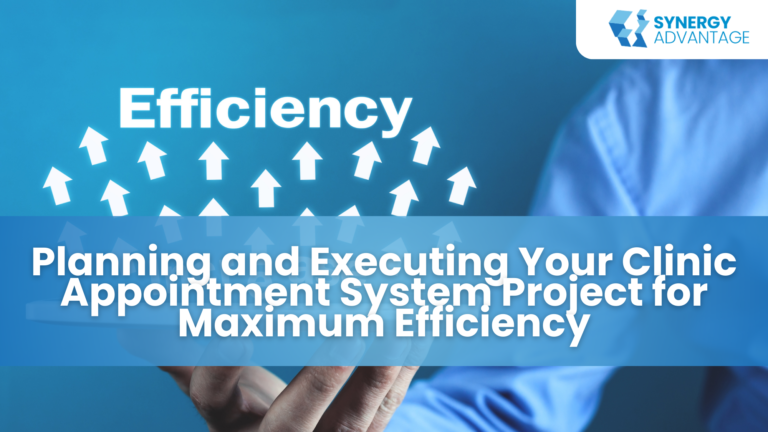In today’s fast-paced healthcare environment, efficiency is paramount. A well-organized clinic appointment system enhances patient satisfaction and optimizes operational workflows. This article delves into the crucial steps required to create a seamless appointment system tailored to your clinic’s unique needs.
From initial planning and stakeholder engagement to the intricacies of execution, this article will guide you through developing an appointment system that minimizes wait times, maximizes productivity, and ultimately improves patient care. Whether you’re a clinic administrator or a healthcare provider, harnessing these strategies will pave the way for a more efficient and patient-centric practice.
Key Takeaways
- Efficient clinic appointment systems cut down on waiting times and missed appointments. They use reminders to help with this.
- Checking how your clinic books appointments can show where things need to improve. You might find delays or tools that are hard to use.
- Picking the right system means it should fit what your clinic needs, be easy for staff to use, and work well with other tech you have.
- Teaching staff how to use the new system is essential. Also, moving data safely keeps patient info secure during changes.
Introduction to Clinic Appointment System Projects

Efficient clinic appointment systems are crucial for reducing patient wait times and enhancing satisfaction. By utilizing automated reminders, these systems decrease no-shows and cancellations, improving operational efficiency. Additionally, they aid staff planning by analyzing past data to prevent overwork while maintaining productivity.
A study involving 12,825 patients across 47 medical practices established a strong link between appointment scheduling and patient satisfaction. It revealed that a 10% increase in same-day appointments resulted in an 8% decrease in patient happiness, indicating that simply increasing access does not necessarily enhance satisfaction. Inefficient scheduling can prolong wait times and frustrate staff, negatively impacting service quality. Therefore, strategic use of varied appointment types is essential for patient contentment and effective clinic operations.
Assessing Current Workflows and Identifying Inefficiencies
Evaluating the appointment scheduling process is essential to understanding how well a clinic meets patient needs. First, assess the time required to book an appointment to identify delays that prolong patient wait times. Check if patients frequently wait past their scheduled time, as these delays can lead to dissatisfaction and increased stress for staff. Examine the rate of missed appointments, which wastes both time and resources.
Evaluate whether staff encounter difficulties with booking tools, as cumbersome systems can slow operations and increase errors. Gather patient feedback regarding the booking process to identify areas needing improvement. Additionally, high or low clinic activity periods should be observed to inform better scheduling practices. Finally, analyze how fluctuations in patient flow impact service times, as these changes can lead to backlogs or idle periods.
After reviewing the scheduling system, it becomes evident that several components are problematic. High no-show rates significantly affect clinics; reminder calls can reduce these by 30%. A poorly designed clinic layout can extend visit durations, contributing to delays. The unavailability of updated medical records complicates patient communication, while inefficient handling of medication refills wastes valuable time.
Interactions with insurance companies can further slow post-visit processes. Inefficient appointment scheduling leads to prolonged waiting times, negatively impacting patient satisfaction and the clinic’s reputation. Patients may experience significant delays before seeing their doctors, and errors in scheduling can result in increased workload for staff, who spend hours correcting mistakes.
Selecting the Right Clinic Appointment System

Selecting an effective clinic appointment system is essential for healthcare administrators and practice managers. A suitable system should efficiently manage appointment scheduling, billing, and patient management while ensuring compliance with HIPAA regulations to protect patient information. Integration with electronic health records (EHRs) enhances overall efficiency, and a user-friendly interface facilitates easy adoption by staff. Testing a demo can provide insight into the system’s usability, ensuring staff can adapt without frustration.
To identify the best appointment management solutions, administrators and managers should follow these steps:
- List clinic needs – Identify essential features required by the clinic.
- Set a budget – Determine the financial investment available for new software.
- Research options – Explore medical appointment scheduling systems online.
- Check features – Ensure they align with the clinic’s requirements.
- Request demos – Evaluate the software’s usability through demonstrations.
- Read reviews – Gather feedback from other clinics regarding the software.
- Assess ease of use – Select a user-friendly system for all staff.
- Consider support services – Opt for providers offering reliable assistance.
- Verify compatibility – Ensure the new system integrates seamlessly with existing technologies.
- Test performance – Use real-life scenarios to evaluate the system’s usability.
Evaluating whether the new clinic appointment system integrates effectively with existing practice systems is crucial. IT experts are instrumental in this process, assessing compatibility to ensure smooth operations from appointment booking to patient data management. Additionally, verifying that the new system complies with regulatory requirements is vital, as the exemplary system should automatically track compliance and integrate with the clinic’s current technologies.
Strategic Approach to System Implementation
- Hold a kick-off meeting – Share the vision of the new system and explain how it will simplify work.
- Organize accessible training sessions – Schedule training at convenient times to accommodate different staff schedules.
- Request custom training materials from the outsourced company – Tailor training resources to align with the clinic’s operational practices.
- Establish a help desk – Provide a support resource for staff to address ongoing questions quickly.
- Encourage user feedback – Utilize surveys to gather insights on the system’s effectiveness.
- Monitor the system’s impact – Regularly assess how the system benefits the clinic and share success stories to maintain motivation.
- Engage specialists – Hire experts to facilitate data management and migrate processes.
- Reduce the data volume – Only migrate essential data to the new system.
- Utilize data management tools – Employ tools like Informatica and IBM InfoSphere to organize data before migration.
- Backup all data – Ensure data is securely backed up before migration to mitigate risks.
- Continuously analyze data – Monitor performance metrics to inform operational
Benefits of Using Synergy Advantage’s Clinic Appointment Management Solutions
Streamlining scheduling processes enhances clinic efficiency, and Synergy Advantage’s tools contribute by simplifying appointment booking. These systems reduce staff’s time on phone calls and paperwork, allowing more time for patient care. Features like automated reminders decrease the likelihood of missed appointments.
These solutions identify potential bottlenecks and improve workflow efficiency by analyzing patient visit patterns, resulting in shorter patient wait times and more productive clinic operations. Synergy Advantage’s solutions alleviate administrative burdens by minimizing paperwork and manual tasks, giving staff more time to focus on patient care.
Online forms reduce the need for handwritten documentation, while automated billing and consolidated patient records lead to fewer errors and faster information access. This streamlined approach enables clinics to operate more effectively. Reducing the administrative workload allows clinic staff to concentrate on enhancing patient care, increasing patient satisfaction.
With Synergy Advantage’s solutions, clinics can offer 24/7 online booking, enabling patients to schedule appointments at their convenience. Additionally, the system’s reminder functionality reduces missed appointments and last-minute cancellations, fostering a patient-centered approach that improves clinic operations. Satisfied patients are likely to leave positive reviews and provide referrals, making an effective appointment system vital for ensuring a positive care experience.
Conclusion
For healthcare administrators, practice managers, and clinic owners, the “Edoc” project represents a significant advancement. This open-source PHP web application simplifies the process of booking medical appointments. Users can effortlessly add or remove doctors, schedule sessions, and access patient information with just a few clicks. By reducing waiting times and enhancing clinic workflow, it allows patients to book appointments online and review their past bookings.
Additionally, the system helps doctors track appointments and monthly earnings, which is essential for effective financial management. Transitioning to this system enables clinics to move away from outdated scheduling methods that hinder efficiency. An effective appointment system streamlines clinic operations by minimizing errors associated with manual scheduling, ensuring that data remains secure and easily accessible.
Patients appreciate the convenience of hassle-free booking, which increases the likelihood of their return. Doctors benefit from improved time and resource management through these systems. A robust internet connection and a reliable database are crucial for maintaining patient data security and accessibility. Moreover, a dependable appointment system enhances clinic efficiency.
Synergy Advantage further elevates your clinic operations by refining and implementing clinic appointment systems tailored to specific needs!
FAQs
1. What is a clinic appointment system project?
A clinic appointment system project is an initiative to streamline scheduling and managing appointments in a healthcare setting for maximum efficiency.
2. How can I plan my clinic appointment system project effectively?
Effective planning involves understanding your current systems, identifying areas that need improvement, selecting suitable software, and developing an implementation timeline.
3. What strategies can help execute the clinic appointment system project efficiently?
Efficient execution requires proper training for staff members, regular monitoring of the new system’s performance, making necessary adjustments along the way, and ensuring seamless integration with existing operations.
4. Can changes be made once the clinic appointment system project has been implemented?
Absolutely! Continuous evaluation post-implementation allows you to identify issues or inefficiencies and make necessary changes to ensure maximum productivity.
References
Ala A, Chen F. Appointment Scheduling Problem in Complexity Systems of the Healthcare Services: A Comprehensive Review. J Healthc Eng. 2022;2022:5819813. Published 2022 Mar 3. doi:10.1155/2022/5819813 https://pmc.ncbi.nlm.nih.gov/articles/PMC8913063/
Sampson F, Pickin M, O’Cathain A, Goodall S, Salisbury C. Impact of same-day appointments on patient satisfaction with general practice appointment systems. Br J Gen Pract. 2008 Sep;58(554):641-3. doi: 10.3399/bjgp08X330780. PMID: 18801282; PMCID: PMC2529202. https://pubmed.ncbi.nlm.nih.gov/18801282/
Zhao P, Yoo I, Lavoie J, Lavoie BJ, Simoes E. Web-Based Medical Appointment S : A Systematic Review. J Med Internet Res. 2017;19(4):e134. Published 2017 Apr 26. doi:10.2196/jmir.6747 https://pmc.ncbi.nlm.nih.gov/articles/PMC5425771/

